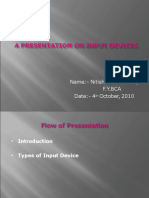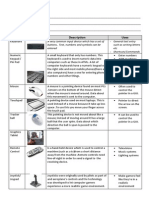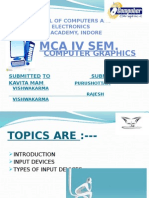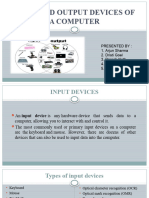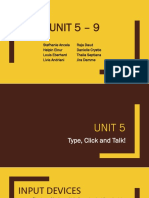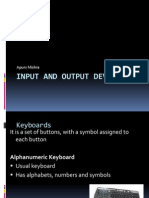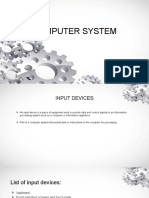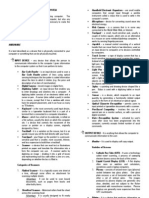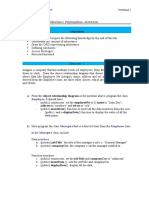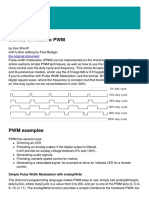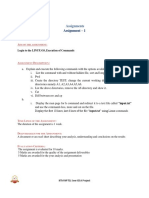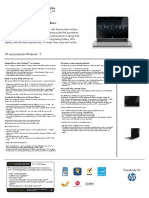BCA– 102 Computer Fundamentals & MS Office
NotesUnit-2
1. Computer Input Devices
Following are some of the important input devices which are used in a computer−
Keyboard
Mouse
JoyStick
Lightpen
TrackBall
Scanner
GraphicTablet
Microphone
MagneticInkCardReader(MICR)
OpticalCharacterReader(OCR)
BarCodeReader
OpticalMarkReader(OMR)
Keyboard
Keyboard is the most common and very popular input device which helps to input data to
thecomputer. The layout of the keyboard is like that of traditional typewriter, although there
aresomeadditionalkeysprovidedforperformingadditionalfunctions.
Dr Chandani Sharma
�Keyboardsareoftwosizes84keysor101/102keys,butnowkeyboardswith104keysor108keysarealsoavaila
ble for Windows andInternet.
Thekeysonthekeyboardareasfollows−
S.No Keys&Description
1 TypingKeys
Thesekeysincludetheletterkeys(A-Z)anddigitkeys(09)whichgenerallygivethesame
layout as that of typewriters.
NumericKeypad
2 Itisusedtoenterthenumericdataorcursormovement.Generally,itconsistsofa set of
17 keys that are laid out in the same configuration used by most
addingmachinesand calculators.
FunctionKeys
3 The twelve function keys are present on the keyboard which are arranged in
arow at the top of the keyboard. Each function key has a unique meaning and
isusedforsomespecificpurpose.
Controlkeys
These keys provide cursor and screen control. It includes four directional
4 arrowkeys. Control keys also include Home, End, Insert, Delete, Page Up, Page
Down,Control(Ctrl),Alternate(Alt), Escape(Esc).
Dr Chandani Sharma
� SpecialPurposeKeys
5 KeyboardalsocontainssomespecialpurposekeyssuchasEnter,Shift,CapsLock,Num
Lock, Spacebar, Tab,and Print Screen.
Mouse
Mouse is the most popular pointing device. It is a very famous cursor-control device having
asmall palm size box with a round ball at its base, which senses the movement of the mouse
andsendscorresponding signals to the CPU when the mousebuttonsarepressed.
Generally, it has two buttons called the left and the right button and a wheel is present
betweenthe buttons.A mouse can be used tocontrolthe position of the cursoron the screen,
butitcannotbe used to enter text into thecomputer.
Advantages
Easytouse
Notveryexpensive
Movesthecursorfasterthanthearrowkeysofthekeyboard.
MechanicalMouse
Amechanicalmouseisconsideredasthetraditionalmouseandisnowreplacedbyopticalmouse. A
mechanical mouse has a ball on the bottom, which is attached to the system unitthroughacord.
Amechanical mouserequires periodiccleaning.
OpticalMouse
Optical Mouse is widely used these days. Like the mechanical mouse, it does not have
anymoving parts. It emits & senses light to detect mouse movements. Optical mouse can be used
onanysurfacewithgreat precisionas compared toMechanicalmouse.
Dr Chandani Sharma
� WirelessMouse
Awirelessmouseorcordlessmouseusesinfraredorradiowarestocommunicatewiththesystem units. A
wireless mouse is battery powered and can be connected to a laptop or tabletcomputer.
Joystick
Joystick is also a pointing device,which is used to move the cursor position on a monitorscreen.
It is a stick having a spherical ball at its both lower and upper ends. The lower
sphericalballmoves in asocket.Thejoystickcan bemovedin all fourdirections.
Thefunctionofthejoystickissimilartothatofamouse.ItismainlyusedinComputerAidedDesigning(C
AD) and playing computergames.
LightPen
Lightpenisapointingdevicesimilartoapen.Itisusedtoselectadisplayedmenuitemordraw pictures on
the monitor screen. It consists of a photocell and an optical system placed in asmall tube.
Dr Chandani Sharma
� When the tip of a light pen is moved over the monitor screen and the pen button is pressed,
itsphotocell sensing element detects the screen location and sends the corresponding signal to
theCPU.
TrackBall
Track ball is an input device that is mostly used in notebook or laptop computer, instead of
amouse. This is a ball which is half inserted and by moving fingers on the ball, the pointer can
bemoved.
Since the whole device is not moved, a track ball requires less space than a mouse. A track
ballcomesin various shapes like aball, abutton, orasquare.
TouchScreen
A touch screen is a particular kind of monitor screen covered with a plastic layer. Behind
thislayer are crisscrossed invisible beams of infrared light. This arrangement enables someone
toperform actions by touching the screen with a finger or stylus. With it growing popularity
touchscreensareused insmartphones, AutomatedTeller Machine (ATM)etc.
SCANNINGDEVICES
Deviceusedtoscantextdocuments,images,objectsandconvertitintodigitalimage.
Scanningtechnologythatconvertsphysicalimage,textintodigitalimagefileontheco
mputer.
Scanslightanddarkareaaswellascoloronscanneddocument.
Dr Chandani Sharma
� Afterscanningtheseimagescanbeprintedonpaperorstoredonstoragedevices.
3DScanneralsoexistbutcostishigh.
OpticalScanner
Ascannerreadsdataorinformationfromasource.Thissourcecanbeawrittendocument,onanimage.Asc
anner,also calledopticalscanner cancopyorreproducetextaswell asimages.
Scanner
Scanner is an input device, which works more like a photocopy machine. It is used when
someinformation is available on paper and it is to be transferred to the hard disk of the computer
forfurthermanipulation.
Scanner captures images from the source which are then converted into a digital form that
canbe stored on the disk. These images can be edited before they are printed. There are
severaltypes ofscanners:
FlatbedScanners
The most commonly used scanner is a flatbed scanner also known as desktop scanner. It has
aglass plate on which the picture or the document is placed. The scanner head placed beneath
theglassplatemoves across the pictureand theresult
Dr Chandani Sharma
� is a good quality scanned image. For scanning large maps or toposheets wide format
flatbedscanners can beused.
SheetfedScanners
Sheet fed scanners work on a principle similar to that of a fax machine. In this, the document
tobe scanned is moved past the scanning head and the digital form of the image is obtained.
Thedisadvantage of this type of scanner is that it can only scan loose sheets and the scanned
imagecaneasily become distortedif thedocumentis nothandledproperly whilescanning.
HandheldScanners
Hand-held scanners although portable, can only scan images up to about four inches wide.
Theyrequire a very steady hand for moving the scan head over the document. They are useful
forscanningsmalllogosorsignaturesandarevirtuallyofnouseforscanningmapsandphotographs.
Digitizer
Digitizer is an input device which converts analog information into digital form. Digitizer
canconvert a signal from the television or camera into a series of numbers that could be stored
in
acomputer.Theycanbeusedbythecomputertocreateapictureofwhateverthecamerahadbeenpointed
at.
A tabletis a computing device that is controlled with a finger or a digital pen called a stylus.
Atablet is usually larger than a smart phone, but smaller than a computer monitor. Some
tabletshaveascreen,whichistoucheddirectly,andsometabletsareperipheraldevices,withoutscreens,
which attach to a computer. The user can write, draw, and paint by touching the
tablet.Softwareconvertstheanalogtouchinputtolinesorpressure-sensitivebrushstrokesinadocument.
The software may also perform handwriting recognition to convert handwritten text
totypewritten words. When dealing with graphics these tablets are often referred to as a
graphicstablet.
A graphics tablet (also known as a digitizer, drawing tablet, drawing pad, digital drawing
tablet,pen tablet, or digital art board) is a computer input device that enables a user to hand-
drawimages, animations and graphics, with a special pen- like stylus, similar to the way a
persondrawsimageswithapenciland...and
Dr Chandani Sharma
� paper. These tablets may also be used to capture data or handwritten signatures. It can also
beused to trace an image from a piece of paper which is taped or otherwise secured to the
tabletsurface. Capturing data in this way, by tracing or entering the corners of linear poly-lines
orshapes,is called digitizing.
Digitizer is also known as Tablet or Graphics Tablet as it converts graphics and pictorial
datainto binary inputs. A graphic tablet as digitizer is used for fine works of drawing and
imagemanipulationapplications.
MagneticInkCardReader(MICR)
MICR input device is generally used in banks as there are large number ofcheques to
beprocessed every day. The bank's code number and cheque number are printed on the
chequeswithaspecialtypeofinkthatcontainsparticlesof magneticmaterialthataremachinereadable.
MICR (magnetic ink character recognition) is a technology used to verify the legitimacy
ororiginality of paper documents, especially checks. Special ink, which is sensitive to
magneticfields, is used in the printing of certain characters on the original documents.
Information can beencodedin themagneticcharacters.
The use of MICR can enhance security and minimize the losses caused by some types of
crime.If a document has been forged- for example, a counterfeit check produced using a
colorphotocopying machine, the magnetic-ink line will either not respond to magnetic fields, or
willproduce an incorrect code when scanned using a device designed to recover the information
inthemagneticcharacters.
Dr Chandani Sharma
� ThisreadingprocessiscalledMagneticInkCharacterRecognition(MICR).Themainadvantagesof
MICR are that itis fast and less error prone.
OpticalCharacterReader(OCR)
OCRisaninputdeviceusedtoreadaprintedtext.
OCR scans the text optically, character by character, converts them into a machine
readablecode,and stores the texton the system memory.
OCR technology can be used to convert a hard copy of a document into an electronic version
(orsoft copy. For example, if you scan a multipage document into a digital image, such as a
TIFFfile, you can load the document into an OCR
program,whichwillrecognizethetextandconvertthedocumenttoaneditable
Dr Chandani Sharma
� textfile.SomeOCRprogramsallowyoutoscanadocumentandconvertitto a wordprocessingdocument
in asinglestep.
A scanner merely copies the paper as an image file, so you cannot copy and paste from
thedocument.OCRtranslatesadocumentintoaneditableformat,andsomedatabaseprogramsm
aybeabletoacceptinputdirectlyfromtheOCR reader.
BarCodeReaders
Bar Code Reader is a device used for reading bar coded data (data in the form of light and
darklines). Bar coded data is generally used in labeling goods, numbering the books, etc. It may
be ahandheldscanner ormaybeembedded inastationary scanner.
A barcode is a set of lines of different widths and sizes representing data, that when read
helpidentify the scanned object. Barcodes are often used to help organize and index information
orpricesabout an object.
It can also load the details of the product or log information about that product into a
database.An example of a barcode reader is a supermarket barcode scanner that reads and logs
the price ofaproduct. Today, many smart phoneswith the
properappsarealsocapableofscanningandreadingbarcodes.
OpticalMarkReader(OMR)
OMRisaspecialtypeofopticalscannerusedtorecognizethetypeofmarkmadebypenorpencil.It isused
whereoneoutof afewalternatives isto beselectedandmarked.
Dr Chandani Sharma
� It is specially used for checking the answer sheets of examinations havingmultiple
choicequestions.
OMR allows for the processing of hundreds or thousands of documents per hour. For
example,students may recall taking tests or surveys where they filled in bubbles on paper (shown
right)with a pencil. Once the form had been completed, a teacher or teacher's assistant would
feed thecardsinto a system that grades or gathersinformation from them.
CARDREADER
"Card reader"is the generic term for an input device that reads flashmemory
cards.It can be a standalonedevice that connects to a computer via USB orit may be
integrated into a computer, printer, or multifunction device. In fact, most
multifunctionprinter/scanner/copiersnowhavebuilt-
incardreaders.Mostcardreadersacceptmultiplememorycardformats,includingcompactflash(CF),se
curedigital(SD),andSony'sMemoryStick.Somecardreaders accept various other formats such as
XD, SmartMedia,Microdrive,and MemoryStick Pro Duo cards.
The purpose of a card reader is, not surprisingly, to read the data from a memory card. When
youplace a memory card into a card reader, it will often show up on your computer as a
mounteddisk. You can then view the contents of the memory card by double-clicking the card's
icon. Thisicon typically appears on the desktop of Macintosh computers or inside "My
Computer" onWindowsmachines.
Sincememorycardsmostoftencontainpicturesfromdigitalcameras,aphotoorganizationprogrammayautomaticall
y openwhenyou insert amemorycardinto
Dr Chandani Sharma
� your card reader. This provides an easy way of importing your pictures into your photo album.
Ifyou don't want to import photos using the program, you can simply close the program and
thecardwill still be mounted on yourcomputer.
Imagecapturingdevices-Digitalcameras
Digital camera records and stores photographic images in digital form. Many current models
arealso able to capture sound or video, in addition to still images. Capture is usually
accomplishedby use of a photosensor, using a charged coupled device (CCD). These stored
images can
beuploadedtoacomputerimmediatelyorstoredinthecamerafortobeuploadedintoacomputeror printer
later. Images may also be archived on a photographic compact disc or external harddisk.
Most digital cameras have a LCD for viewing both images in the viewfinder and those in
thecamera's memory. Kodak, Canon, Sony, Nikon, Olympus and several other companies
makedigitalcameras.
Computer-OutputDevices
Followingaresomeoftheimportantoutputdevicesusedinacomputer.
Monitors
GraphicPlotter
Printer
Monitors
Monitors,commonlycalledas VisualDisplayUnit(VDU),arethemainoutput
deviceofacomputer.Itformsimagesfromtinydots,calledpixelsthatarearrangedinarectangularform.
Thesharpness of the imagedepends upon thenumberof pixels.
Therearetwokindsofviewingscreenusedformonitors.
Cathode-RayTube(CRT)
Flat-PanelDisplay
Dr Chandani Sharma
� Cathode-RayTube(CRT)Monitor
The CRT display is made up of small picture elements called pixels. The smaller the pixels,
thebetter the image clarity or resolution. It takes more than one illuminated pixel to form a
wholecharacter,suchasthe letter ‘e’in theword help.
A finite number of characters can be displayed on a screen at once. The screen can be
dividedinto a series of character boxes - fixed location on the screen where a standard character
can beplaced. Most screens are capable of displaying 80 characters of data horizontally and 25
linesvertically.
TherearesomedisadvantagesofCRT−
LargeinSize
HighpowerconsumptionFlat-
PanelDisplay Monitor
Theflat-paneldisplayreferstoaclassofvideodevicesthathavereduced volume,
weight and power requirement in comparison to the CRT. You can hang them on walls or
wearthemonyour wrists.Currentusesof flat-paneldisplaysinclude calculators, video
games,monitors,laptop computer, and graphics display.
Dr Chandani Sharma
� Theflat-paneldisplayisdividedintotwocategories−
Emissive Displays − Emissive displays are devices that convert electrical energy
intolight.Forexample, plasmapaneland LED(Light-Emitting Diodes).
Non-Emissive Displays − Non-emissive displays use optical effects to convert
sunlightor light from some other source into graphics patterns. For example, LCD
(Liquid-CrystalDevice).
1. LiquidCrystalDisplay(LCD)Screens
Thesescreensareflat,
need only a small amount of power to run
andcanbepowered by batteries.
Theydonotweighasmuchasordinarymonitors.
Thismeansthey are idealfor useonlaptops and
palmtop's.
Liquid crystals work by blocking light reflected
frombehind, so the screens cannot be read in the dark
unlesstheyarebacklit
Dr Chandani Sharma
�ThinFilmTransistor(TFT)Screens
TFTisatypeofLCDscreenthat
hasmorecomplexelectronicsthananordinarypassiveL
CD.
Itusesarraysoftransistorstocontrol
backlightingofthescreenactively.
Theseenableittodisplaygraphicsandanimation
s much more clearly and quicklythanan
ordinary LCDand
candisplaymovinggraphicswithout‘shadow
ing’.
Printers
A printer is a device that accepts text and graphic output from a computer and transfers
theinformation to paper, usually to standard size sheets of paper. Printers varyin size,
speed,sophistication, and cost. In general, more expensive printers are used for higher-resolution
colorprinting.
Thefourprinterqualitiesofmostinteresttomostusersare:
Color: Color is important for users who need to print pages for presentations or maps
andother pages where color is part of the information. Color printers can also be set to print
onlyin black-and-white. Color printers are more expensive to operate since they use two
inkcartridges (one color and one black ink) that need to be replaced after a certain number
ofpages. Users who don't have a specific need for color and who print a lot of pages will find
ablack-and-whiteprintercheaper to operate.
Resolution:Printerresolution(thesharpnessoftextandimagesonpaper)isusuallymeasured in
dots per inch (dpi). Most inexpensive printers provide sufficient resolution formostpurposes
at 600 dpi.
Speed: If you do much printing, the speed of the printer becomes important.
Inexpensiveprinters print only about 3 to 6 sheets per minute. Color printing is slower. More
expensiveprintersaremuch faster.
Memory: Most printers come with a small amount of memory (for example, one
megabyte)that can be expanded by the user. Having more than the minimum amount of
memory
ishelpfulandfasterwhenprintingoutpageswithlargeimagesortableswithlinesaroundthem(which
the printer treats as alargeimage).
Dr Chandani Sharma
� Printerisanoutputdevice,whichisusedtoprintinformationonpaper.Thereare
Dr Chandani Sharma
� twotypes ofprinters−
ImpactPrinters
Non-ImpactPrinters
ImpactPrinters
Impactprintersprintthecharactersbystrikingthemontheribbon,whichisthenpressedonthepaper.
CharacteristicsofImpactPrintersarethefollowing−
Verylowconsumablecosts
Verynoisy
Usefulforbulkprintingduetolowcost
ThereisphysicalcontactwiththepapertoproduceanimageTheseprintersar
eof two types−
Characterprinters
Lineprinters
CharacterPrinters
Characterprintersaretheprinterswhichprintonecharacter atatime.These arefurtherdivided
intotwo types:
DotMatrixPrinter(DMP)
DaisyWheel
DotMatrixPrinter
In the market, one of the most popular printers is Dot Matrix Printer. These printers are
popularbecause of their ease of printing and economical price. Each character printed is in the
form ofpattern of dots and head consists of a Matrix of Pins of size (5*7, 7*9, 9*7 or 9*9)
which comesoutto form a character whichis why it is called DotMatrix Printer.
Dr Chandani Sharma
� Advantages
Inexpensive
WidelyUsed
Otherlanguagecharacterscanbeprinted
Disadvantages
SlowSpeed
PoorQuality
DaisyWheel
Head is lying on a wheel and pins corresponding to characters are like petals of Daisy
(flower)which is why it is called Daisy Wheel Printer. These printers are generally used for
word-processingin offices thatrequireafew letters tobesent hereandtherewith very nicequality.
Advantages
Dr Chandani Sharma
� MorereliablethanDMP
Betterquality
Fontsofcharactercanbeeasilychanged
Disadvantages
SlowerthanDMP
Noisy
MoreexpensivethanDMP
LinePrinters
Lineprintersaretheprinterswhichprintonelineatatime.
Theseareoftwotypes−
DrumPrinter
ChainPrinter
DrumPrinter
This printer is like a drum in shape hence it is called drum printer. The surface of the drum
isdivided into a number of tracks. Total tracks are equal to the size of the paper, i.e. for a
paperwidth of 132 characters, drum will have 132 tracks. A character set is embossed on the
track.Different character sets available in the market are 48 character set, 64 and 96 characters
set.One rotation of drum prints one line. Drum printers are fast in speed and can print 300 to
2000linesperminute.
Advantages
Veryhighspeed
Dr Chandani Sharma
� Disadvantages
Veryexpensive
Charactersfontscannotbechanged
ChainPrinter
Inthisprinter,achainofcharactersetsisused,henceitiscalledChainPrinter.Astandardcharacterset may
have48, 64, or96 characters.
Advantages
Characterfontscaneasilybechanged.
Differentlanguagescanbeusedwiththesameprinter.
Disadvantages
Noisy
Non-impactPrinters
Non-impactprintersprintthecharacterswithoutusingtheribbon.Theseprintersprintacompletepageat
a time,thus they arealso calledas PagePrinters.
Theseprintersareoftwo types−
LaserPrinters
InkjetPrinters
CharacteristicsofNon-impactPrinters
Fasterthanimpactprinters
Theyarenotnoisy
Highquality
Supportsmanyfontsanddifferentcharactersize
LaserPrinters
Thesearenon-impactpageprinters.Theyuselaserlightstoproducethedotsneededtoformthecharacters
to beprinted on apage.
Dr Chandani Sharma
� Advantages
Veryhighspeed
Veryhighqualityoutput
Goodgraphicsquality
Supportsmanyfontsanddifferentcharactersize
Disadvantages
Expensive
Cannotbeusedtoproducemultiplecopiesofadocumentinasingleprinting
InkjetPrinters
Inkjet printers are non-impact character printers based on a relatively new technology.
Theyprint characters by spraying small drops of ink onto paper. Inkjet printers produce high
qualityoutputwith presentablefeatures.
Dr Chandani Sharma
� They make less noise because no hammering is done and these have many styles of
printingmodes available. Color printing is also possible. Some models of Inkjet printers can
producemultiplecopies ofprinting also.
Advantages
Highqualityprinting
Morereliable
Disadvantages
Expensiveasthecostperpageishigh
Slowascomparedtolaserprinter
Plotter
A plotterisacomputerhardwaredevicemuchlikeaprinterthatisusedfor
printingvectorgraphics.Insteadof toner,plottersusea pen,pencil,marker,or anotherwritingtoolto
drawmultiple, continuouslinesontopaperratherthana
seriesofdotslikeatraditionalprinter.Thoughoncewidelyusedfor computer-
aideddesign,thesedeviceshavemoreorless been phased out by wide-format printers. Plotters
produce a hard copy of schematics andother
similarapplications.Thefirstplotterwasinventedin1953byRemington-
Rand.Itwasusedinconjunctionwith the UNIVACcomputerto createdtechnicaldrawings.
Advantagesofplotters
Plotterscanworkonverylargesheetsofpaperwhilemaintaininghighresolution.
Theycanprintonawidevarietyof flatmaterials
includingplywood,aluminum,sheetsteel, cardboard, and plastic.
Dr Chandani Sharma
� Plottersallowthesamepatterntobedrawnthousandsoftimeswithoutanyimage
Dr Chandani Sharma
� degradation.
Disadvantagesofplotters
Plottersarequitelargecomparedtoatraditionalprinter.
Plottersarealsomuchmoreexpensivethanatraditionalprinter.
Projector
A projector or image projector is an optical device that projects an image (or moving
images)onto a surface, commonly a projection screen. Most projectors create an image by
shining a lightthrough a small transparent lens, but some newer types of projectors can project
the
imagedirectly,byusinglasers.Avirtualretinaldisplay,orretinalprojector,isaprojectorthatprojectsani
magedirectlyontheretinainsteadof usingan externalprojection screen.
The most common type of projector used today is called a video projector. Video
projectorsaredigitalreplacementsforearliertypesofprojectorssuchasslideprojectors and
overheadprojectors. These earlier types of projectors were mostly replaced with digital video
projectorsthroughoutthe1990sandearly2000s,butoldanalogprojectorsarestillusedatsomeplaces.The
newest types of projectors are handheld projectors that use lasers or LEDs to project
images.Theirprojections arehard to seeif thereis too much ambient light.
Movietheatersused atypeofprojectorcalledamovieprojector,nowadays mostlyreplaced
withdigitalcinemavideo projectors.
Dr Chandani Sharma
�DifferencebetweenImpactandNon-ImpactPrinters
Dr Chandani Sharma



